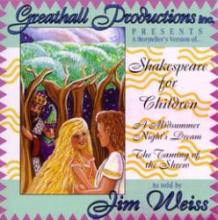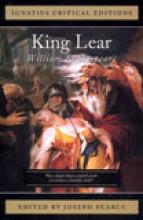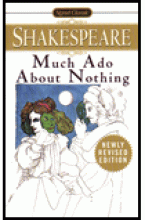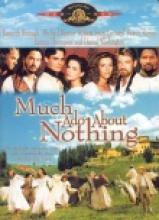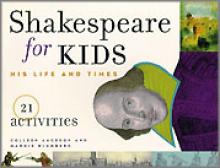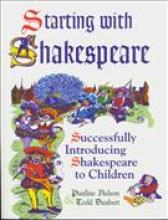William Shakespeare
A Storyteller's Version of Shakespeare for Kids
Jim Weiss also has produced a version of Romeo and Juliet.
In Search of Shakespeare
King Lear
Much Ado About Nothing
Much Ado About Nothing
During the credits, the men and women (who are in separate places) are shown bathing and dressing up while preparing to meet each other after the men had been away at war. While this is done in a fairly innocent manner, there are plenty of naked "backsides" in this scene.
There is a small scene during the costumed party involving a couple who are not behaving themselves very well. It does help establish their characters which play an essential role in the story. Although it is not terribly graphic (and might go unnoticed by small children), it is probably not suitable for younger viewers.
Directed by Kenneth Branagh, PG-13, 1 hr. 51 min., Color
Starring: Kennegth Branagh, Michael Keaton, Keanu Reeves, Emma Thompson and Denzel Washington
Othello
Written c. 1601-1604
Many editions available. "Interleaved" editions (original text with notes on facing page) are helpful.
Shakespeare for Kids
This book was donated for review by Chicago Review Press.
Starting with Shakespeare
Unit Study-loving families may find in Starting with Shakespeare a very useful resource! This book is literary filled with Shakespeare-related activities! In the introduction we get to know the authors and their passionate belief in the benefits of bringing Shakespeare to elementary school. They are quite convincing with a top 20 reasons list, secrets for success and even some criticism of how memorization has been dropped from school curricula a long time ago. The introduction also helps the reader understand how the book is organized and what to expect. The first part of the book is entitled "Setting the Stage" and it offers biographical sketches on Shakespeare, very detailed ways to get the students interested, and creative tips for success. The second part presents four William Shakespeare plays, "A Midsummer Night's Dream," "Macbeth," "Hamlet," and "Romeo and Juliet" introduced for kids in a unique way alongside a plethora of resources and ideas for each one. As the publisher states: "a complete historical background, an introduction to the characters, a retelling of the story, a variety of integrated activities, verses for memorization, a complete script for class performance, and a list of resources accompany each play. Activities extend learning to history, geography, science, art, music, movement, math, and language arts." Each play is explained, character by character, plot, themes, and then told to children in prose with points for discussion in class. The authors encourage the making of a class film or video, as opposed to a performance, stating that it is simpler to use a video camera than setting up a live performance. What I enjoy about this book is that, albeit geared towards elementary school aged kids, it makes plenty of use of genuine Shakespeare language. Each play is also presented in "Will's Words--Selections for recitation", where key excerpts of the play are quoted on top of the page. Obscure words are defined and explained right below under "Say what?", and then a paragraph explains what is going on in plain English under "Kispeak". The illustrations are all made by elementary school students and some of them are quite interesting. All in all this book can be a wealth of resources for homeschool families daring the tackle the Bard of Avon in elementary or middle (or even high) school!

